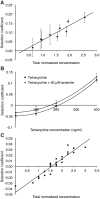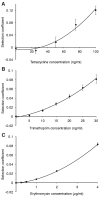Selection of a multidrug resistance plasmid by sublethal levels of antibiotics and heavy metals
- PMID: 25293762
- PMCID: PMC4196238
- DOI: 10.1128/mBio.01918-14
Selection of a multidrug resistance plasmid by sublethal levels of antibiotics and heavy metals
Abstract
How sublethal levels of antibiotics and heavy metals select for clinically important multidrug resistance plasmids is largely unknown. Carriage of plasmids generally confers substantial fitness costs, implying that for the plasmid-carrying bacteria to be maintained in the population, the plasmid cost needs to be balanced by a selective pressure conferred by, for example, antibiotics or heavy metals. We studied the effects of low levels of antibiotics and heavy metals on the selective maintenance of a 220-kbp extended-spectrum β-lactamase (ESBL) plasmid identified in a hospital outbreak of Klebsiella pneumoniae and Escherichia coli. The concentrations of antibiotics and heavy metals required to maintain plasmid-carrying bacteria, the minimal selective concentrations (MSCs), were in all cases below (almost up to 140-fold) the MIC of the plasmid-free susceptible bacteria. This finding indicates that the very low antibiotic and heavy metal levels found in polluted environments and in treated humans and animals might be sufficiently high to maintain multiresistance plasmids. When resistance genes were moved from the plasmid to the chromosome, the MSC decreased, showing that MSC for a specific resistance conditionally depends on genetic context. This finding suggests that a cost-free resistance could be maintained in a population by an infinitesimally low concentration of antibiotic. By studying the effect of combinations of several compounds, it was observed that for certain combinations of drugs each new compound added lowered the minimal selective concentration of the others. This combination effect could be a significant factor in the selection of multidrug resistance plasmids/bacterial clones in complex multidrug environments. Importance: Antibiotic resistance is in many pathogenic bacteria caused by genes that are carried on large conjugative plasmids. These plasmids typically contain multiple antibiotic resistance genes as well as genes that confer resistance to biocides and heavy metals. In this report, we show that very low concentrations of single antibiotics and heavy metals or combinations of compounds can select for a large plasmid that carries resistance to aminoglycosides, β-lactams, tetracycline, macrolides, trimethoprim, sulfonamide, silver, copper, and arsenic. Our findings suggest that the low levels of antibiotics and heavy metals present in polluted external environments and in treated animals and humans could allow for selection and enrichment of bacteria with multiresistance plasmids and thereby contribute to the emergence, maintenance, and transmission of antibiotic-resistant disease-causing bacteria.
Copyright © 2014 Gullberg et al.
Figures



Comment in
-
Widening the spaces of selection: evolution along sublethal antimicrobial gradients.mBio. 2014 Dec 9;5(6):e02270. doi: 10.1128/mBio.02270-14. mBio. 2014. PMID: 25491358 Free PMC article.
References
-
- Liu A, Fong A, Becket E, Yuan J, Tamae C, Medrano L, Maiz M, Wahba C, Lee C, Lee K, Tran KP, Yang H, Hoffman RM, Salih A, Miller JH. 2011. Selective advantage of resistant strains at trace levels of antibiotics: a simple and ultrasensitive color test for detection of antibiotics and genotoxic agents. Antimicrob. Agents Chemother. 55:1204–1210. 10.1128/AAC.01182-10 - DOI - PMC - PubMed
-
- Smet A, Martel A, Persoons D, Dewulf J, Heyndrickx M, Cloeckaert A, Praud K, Claeys G, Catry B, Herman L, Haesebrouck F, Butaye P. 2009. Comparative analysis of extended-spectrum-{beta}-lactamase-carrying plasmids from different members of Enterobacteriaceae isolated from poultry, pigs and humans: evidence for a shared {beta}-lactam resistance gene pool? J. Antimicrob. Chemother. 63:1286–1288. 10.1093/jac/dkp101 - DOI - PMC - PubMed
-
- Kang HY, Kim J, Seol SY, Lee YC, Lee JC, Cho DT. 2009. Characterization of conjugative plasmids carrying antibiotic resistance genes encoding 16S rRNA methylase, extended-spectrum beta-lactamase, and/or plasmid-mediated AmpC beta-lactamase. J. Microbiol. 47:68–75. 10.1007/s12275-008-0158-3 - DOI - PubMed
Publication types
MeSH terms
Substances
LinkOut - more resources
Full Text Sources
Other Literature Sources
Medical
